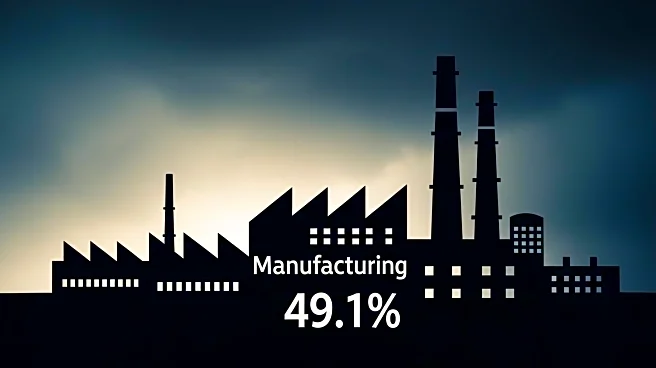What's Happening?
The Institute for Supply Management (ISM) has released its latest Manufacturing PMI report, indicating that the manufacturing sector in the United States contracted for the seventh consecutive month in September. The PMI registered at 49.1%, a slight increase from August's 48.7%. Despite this uptick, the sector remains in contraction, as a PMI below 50% signifies a decline in manufacturing activity. The report highlights that while the Production Index saw a rise to 51%, the New Orders Index fell to 48.9%, suggesting a decrease in demand. Additionally, the Employment Index improved slightly to 45.3%, yet it remains in contraction territory. The Supplier Deliveries Index, which inversely indicates slower deliveries when above 50%, rose to 52.6%, reflecting ongoing supply chain challenges. The report also notes that 67% of the manufacturing sector's GDP contracted in September, with only the Petroleum & Coal Products industry showing expansion.
Why It's Important?
The continued contraction in the manufacturing sector is significant as it reflects broader economic challenges, including supply chain disruptions and fluctuating demand. The manufacturing sector is a critical component of the U.S. economy, and its performance can influence overall economic health. The persistent contraction may impact employment within the sector, as companies manage headcounts rather than expand their workforce. Additionally, the decline in new orders suggests potential future slowdowns in production, which could affect related industries and supply chains. The report's findings may prompt policymakers and industry leaders to consider measures to stimulate growth and address supply chain issues.
What's Next?
Looking ahead, the manufacturing sector may continue to face challenges unless there is a significant increase in demand and resolution of supply chain issues. Industry stakeholders might focus on strategies to boost new orders and production levels. Policymakers could consider interventions to support the sector, such as incentives for domestic production or measures to ease supply chain bottlenecks. The performance of the manufacturing sector in the coming months will be closely monitored as an indicator of broader economic trends.











